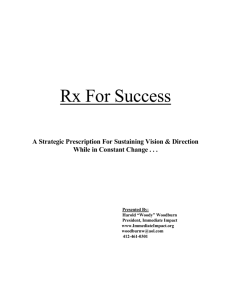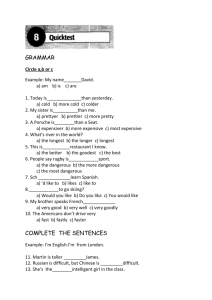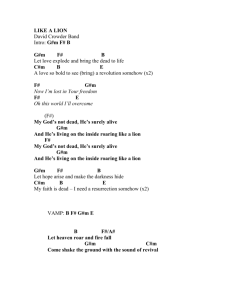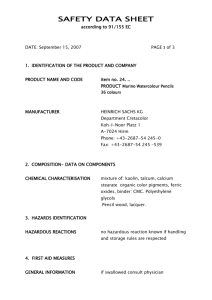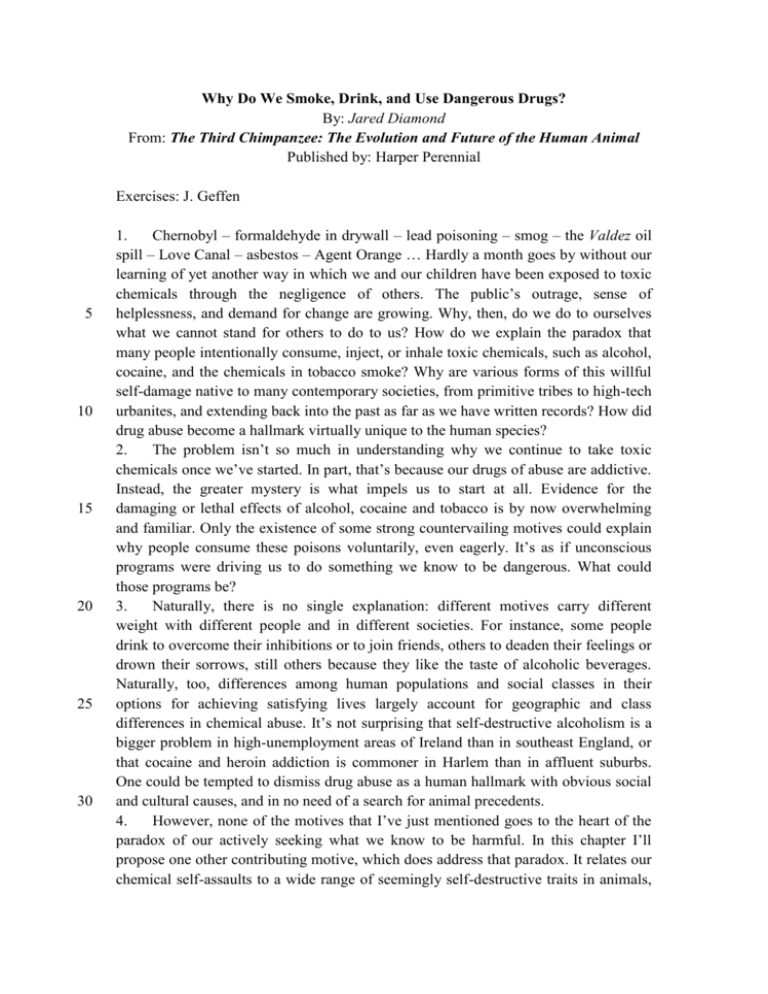
Why Do We Smoke, Drink, and Use Dangerous Drugs?
By: Jared Diamond
From: The Third Chimpanzee: The Evolution and Future of the Human Animal
Published by: Harper Perennial
Exercises: J. Geffen
5
10
15
20
25
30
1.
Chernobyl – formaldehyde in drywall – lead poisoning – smog – the Valdez oil
spill – Love Canal – asbestos – Agent Orange … Hardly a month goes by without our
learning of yet another way in which we and our children have been exposed to toxic
chemicals through the negligence of others. The public’s outrage, sense of
helplessness, and demand for change are growing. Why, then, do we do to ourselves
what we cannot stand for others to do to us? How do we explain the paradox that
many people intentionally consume, inject, or inhale toxic chemicals, such as alcohol,
cocaine, and the chemicals in tobacco smoke? Why are various forms of this willful
self-damage native to many contemporary societies, from primitive tribes to high-tech
urbanites, and extending back into the past as far as we have written records? How did
drug abuse become a hallmark virtually unique to the human species?
2.
The problem isn’t so much in understanding why we continue to take toxic
chemicals once we’ve started. In part, that’s because our drugs of abuse are addictive.
Instead, the greater mystery is what impels us to start at all. Evidence for the
damaging or lethal effects of alcohol, cocaine and tobacco is by now overwhelming
and familiar. Only the existence of some strong countervailing motives could explain
why people consume these poisons voluntarily, even eagerly. It’s as if unconscious
programs were driving us to do something we know to be dangerous. What could
those programs be?
3.
Naturally, there is no single explanation: different motives carry different
weight with different people and in different societies. For instance, some people
drink to overcome their inhibitions or to join friends, others to deaden their feelings or
drown their sorrows, still others because they like the taste of alcoholic beverages.
Naturally, too, differences among human populations and social classes in their
options for achieving satisfying lives largely account for geographic and class
differences in chemical abuse. It’s not surprising that self-destructive alcoholism is a
bigger problem in high-unemployment areas of Ireland than in southeast England, or
that cocaine and heroin addiction is commoner in Harlem than in affluent suburbs.
One could be tempted to dismiss drug abuse as a human hallmark with obvious social
and cultural causes, and in no need of a search for animal precedents.
4.
However, none of the motives that I’ve just mentioned goes to the heart of the
paradox of our actively seeking what we know to be harmful. In this chapter I’ll
propose one other contributing motive, which does address that paradox. It relates our
chemical self-assaults to a wide range of seemingly self-destructive traits in animals,
Why Do We Smoke, Drink, and Use Dangerous Drugs? / 2
35
40
45
50
55
60
65
70
75
and to a general theory of animal signaling. It unifies a wide range of phenomena in
our culture, from smoking and alcoholism to drug abuse. It has potential cross-cultural
validity, for it may explain not just phenomena of the western world but also
otherwise mystifying customs elsewhere, such as kerosene drinking by Indonesian
kung fu experts. I’ll also reach into the past and apply the theory to the seemingly
bizarre practice of ceremonial enemas in ancient Mayan civilization.
5.
Let me begin by relating how I arrived at this idea. One day, I was abruptly
struck by the puzzle that companies manufacturing toxic chemicals for human use
advertise their use explicitly. This business practice would seem a sure route to bankruptcy. Yet, while we don’t tolerate ads for cocaine, ads for tobacco and alcohol are
so widespread that we cease to regard their existence as puzzling. It hit me only after I
had been living with New Guinea hunters in the jungle for many months, far from any
advertising.
6.
Day after day, my New Guinea friends had been asking me about western
customs, and I had come to realize through their astonished responses how senseless
many of our customs are. Then the months of fieldwork ended with one of those sudden
transitions that modern transportation has made possible. On June 25 I was still in the
jungle, watching a brilliant-colored male bird of paradise flap awkwardly across a
clearing, dragging its three-foot-long tail behind it. On June 25 I was sitting in a Boeing
747 jet, reading the magazines and catching up on the wonders of western civilization.
7.
I leafed through the first magazine. It fell open to a page with a photo of a
tough-looking man on horseback chasing cows, and the name of a brand of cigarette
in large letters below. The American in me knew what the photo was about. But part
of me was still in the jungle, looking at that photo naïvely. Perhaps my reaction won’t
seem so strange to you if you try to imagine yourself completely unfamiliar with
western society, seeing the ad for the first time, and trying to fathom the connection
between chasing cows and smoking (or not smoking) cigarettes.
8.
The naïve part of me, fresh out of the jungle, thought: such a brilliant
antismoking ad! It’s well known that smoking impairs athletic ability and causes
cancer and early death. Cowboys are widely regarded as athletic and admirable. This
ad must be a devastating new appeal by the antismoking forces, telling us that if we
smoke that particular brand of cigarette, we won’t be fit to be cowboys. What an
effective message to our youth!
9.
But then it became obvious that the ad had been put there by the cigarette
company itself, which somehow hoped that readers would draw exactly the opposite
message from the ad. How on earth did the company let its public-relations
department talk it into such a disastrous miscalculation! Surely that ad would dissuade
any person concerned about his/her strength and self-image from starting to smoke.
10. Still half immersed in the jungle, I turned to another page. There I saw a photo
of a whiskey bottle on a table, a man sipping presumably the bottle’s contents from a
glass, and an obviously fertile young woman gazing at him admiringly as if she were
Why Do We Smoke, Drink, and Use Dangerous Drugs? / 3
80
85
90
95
100
105
110
115
on the verge of sexual surrender. How can that be? I asked myself. Everyone knows
that alcohol interferes with sexual function, tends to make men impotent, makes one
likely to stumble, impairs judgment, and predisposes to cirrhosis of the liver and other
debilitating conditions. In the immortal words of the porter in Shakespeare’s Macbeth,
“It [alcohol] provokes the desire, but it takes away the performance.” A man with such
performance handicaps should conceal them at all costs from a woman he aims to
seduce. Why is the man in the photo intentionally displaying those handicaps? Do
whiskey manufacturers think that pictures of this impaired individual will help sell
their product? One could expect that Mothers Against Drunk Driving would be the ones
producing such ads, and that the whiskey companies would be suing to prevent
publication.
11. Page after page of ads flaunted the use of cigarettes or strong alcohol, and
hinted at their benefits. There were even pictures of young people smoking in the
presence of attractive members of the opposite sex, as if to imply that smoking too
brought sexual opportunities. Yet any nonsmoker who has ever been kissed by (or
tried to kiss) a smoker knows how severely the smoker’s bad breath compromises his
or her sex appeal. The ads paradoxically implied not just sexual benefits but also
platonic friendships, business opportunities, vigor, health, and happiness, when the
direct conclusion to be drawn from the ads was actually the reverse.
12. As the days passed and I reimmersed myself in western civilization, I gradually
stopped noticing its apparently self-defeating ads. I retreated into analyzing my field
data and wondering instead about an entirely different paradox, involving bird
evolution. But that paradox was what led me finally to understand one rationale
behind cigarette and whiskey ads.
13. The new paradox concerned why that male bird of paradise I had been watching
on June 25 had evolved the impediment of a tail three feet long. Males of other bird of
paradise species evolved other bizarre impediments, such as long plumes growing out
of their eyebrows, the habit of hanging upside-down, and brilliant colors and loud calls
likely to attract hawks. All those features must impair male survival, yet they also
serve as the advertisements by which male birds of paradise woo female birds of paradise.
Like many other biologists, I found myself wondering why male birds of paradise use
such handicaps as advertisements, and why females find the handicaps attractive.
14. At that point I recalled a remarkable paper published in 1975 by an Israeli
biologist, Amotz Zahavi. In that paper Zahavi proposed a novel general theory, still
hotly debated by biologists, about the role of costly or self-destructive signals in
animal behavior. For example, he attempted to explain how deleterious male traits
might attract a female precisely because they constitute handicaps. On reflection, I
decided that Zahavi’s hypothesis might apply to the birds of paradise I studied.
Suddenly I realized, with growing excitement, that his theory perhaps could also be
extended to explain the paradox of our use of toxic chemicals, and our touting it in ads.
Why Do We Smoke, Drink, and Use Dangerous Drugs? / 4
120
125
130
135
140
145
150
155
15. Zahavi’s theory as he proposed it concerned the broad problem of animal communication. All animals need to devise quick, easily understood signals for conveying
messages to their mates, potential mates, offspring, parents, rivals, and would-be
predators. For example, consider a gazelle that notices a lion stalking it. It would be in
the gazelle’s interests to give a signal that the lion would interpret to mean, “I am a
superior fast gazelle! You’ll never succeed in catching me, so don’t waste your time
and energy on trying.” Even if that gazelle really is able to outrun a lion, giving a
signal that dissuades the lion from trying would save time and energy for the gazelle
too.
16. But what signal will unequivocally tell the lion that it’s hopeless? The gazelle
can’t take the time to run a demonstration hundred-yard dash in front of every lion
that shows up. Perhaps gazelles could agree on some quick arbitrary signal that lions
learn to understand: e.g., pawing the ground with the left hind foot means, “I claim
that I’m fast!” However, such a purely arbitrary signal opens the door to cheating: any
gazelle can easily give the signal regardless of its speed. Lions will then catch on that
many slow gazelles giving the signal are lying, and lions will learn to ignore the
signal. It’s in the interests both of lions and of fast gazelles that the signal be
believable. What type of signal could convince a lion of the gazelle’s honesty?
17. The same dilemma arises in the problem of sexual selection and mate choice
that I discussed in earlier chapters. This is especially a problem of how females pick
males, since females invest more in reproduction, have more to lose, and have to be
choosier. Ideally, a female should pick a male for his good genes to pass on to her
offspring. Since genes themselves are hard to assess, a female should look for quick
indicators of good genes in a male, and a superior male should provide such
indicators. In practice, male traits such as plumage, songs, and displays usually serve
as indicators. Why do males “choose” to advertise with those particular indicators,
why should females trust a male’s honesty and find those indicators attractive, and
why do they imply good genes?
18. I’ve described the problem as if a gazelle or courting male voluntarily picks out
some indicator from among many possible ones, and as if a lion or a female decides
on reflection whether it’s really a valid indicator of speed or good genes. In practice,
of course, those “choices” are the result of evolution and become specified by genes.
Those females who select males on the basis of indicators that really denote good
male genes, and those males that use unambiguous indicators of good genes for selfadvertisement, tend to leave the most offspring, as do those gazelles and lions that
spare themselves unnecessary chases.
19. As it turns out, many of the advertising signals evolved by animals pose a
paradox similar to that posed by cigarette ads. The indicators often seem not to
suggest speed or good genes but instead to constitute handicaps, expenses, or sources
of risk. For example, a gazelle’s signal to a lion that it sees approaching consists of a
peculiar behavior termed “stotting.” Instead of running away as fast as possible, the
Why Do We Smoke, Drink, and Use Dangerous Drugs? / 5
160
165
170
175
180
185
190
195
gazelle runs slowly while repeatedly jumping high into the air with stiff-legged leaps.
Why on earth should the gazelle indulge in this seemingly self-destructive display,
which wastes time and energy and gives the lion a chance to catch up? Or think of the
males of many animal species that sport large structures, such as a peacock’s tail or a
bird of paradise’s plumes, that make movement difficult. Males of many more species
have bright colors, loud songs, or conspicuous displays that attract predators. Why
should a male advertise such an impediment, and why should a female like it? These
paradoxes remain an important unsolved problem in animal behavior today.
20. Zahavi’s theory goes to the heart of this paradox. According to his theory, those
deleterious structures and behaviors constitute valid indicators that the signaling
animal is being honest in its claim of superiority, precisely because those traits
themselves impose handicaps. A signal that entails no cost lends itself to cheating,
since even a slow or inferior animal can afford to give the signal. Only costly or
deleterious signals are guarantees of honesty. For example, a slow gazelle that stotted
at an approaching lion would seal its fate, whereas a fast gazelle could still outrun the
lion after stotting. By stotting, the gazelle boasts to the lion, “I’m so fast that I can
escape you even after giving you this head start.” The lion thereby has grounds for
believing in the gazelle’s honesty, and both the lion and the gazelle profit by not
wasting time and energy on a case whose outcome is certain.
21. Similarly, as applied to males displaying toward females, Zahavi’s theory
reasons that any male that has managed to survive despite the handicap of a big tail or
conspicuous song must have terrific genes in other respects. He has proved that he
must be especially good at escaping predators, finding food, and resisting disease. The
bigger the handicap, the more rigorous the test that he has passed. The female who
selects such a male is like the medieval damsel testing her knight suitors by watching
them slay dragons. When she sees a one-armed knight who can still slay a dragon, she
knows that she has finally found a knight with great genes. And that knight, by
flaunting his handicap, is actually flaunting his superiority.
22. It seems to me that Zahavi’s theory applies to many costly or dangerous human
behaviors aimed at achieving status in general or at sexual benefits in particular. For
instance, men who woo women with costly gifts and other displays of wealth are in
effect saying, “I have plenty of money to support you and children, and you can
believe my boast because you see how much money I’m spending now without
blanching.” People who show off expensive jewels, sports cars, or works of art gain
status because the signal can’t be faked; everyone else knows that those ostentatious
objects cost. American Indians of the Pacific Northwest used to seek status by
competing to give away as much wealth as possible in ceremonies known as potlatch
rituals. In the days before modern medicine, tattooing was not only painful but
dangerous because of the risk of infection; hence tattooed people in effect were
advertising two facets of their strength, resistance to disease plus tolerance of pain.
Men on the Pacific island of Malekula have traditionally showed off by the insanely
Why Do We Smoke, Drink, and Use Dangerous Drugs? / 6
200
205
210
215
220
225
230
235
dangerous practice, now imitated elsewhere by bungee jumpers, of building a high
tower and jumping off it headfirst, after tying one end of some stout vines to each
ankle and the other end to the top of the tower. The length of the vines is calculated to
stop the braggart’s plunge while his head is still a few feet above the ground. Survival
guarantees that the jumper is courageous, carefully calculating, and a good builder.
23. Zahavi’s theory can also be extended to human abuse of chemicals. Especially
in adolescence and early adulthood, the age when drug abuse is most likely to begin,
we are devoting much energy to asserting our status. I suggest that we share the same
unconscious instinct that leads birds to indulge in dangerous displays. Ten thousand
years ago, we “displayed” by challenging a lion or a tribal enemy. Today, we do it in
other ways, such as by fast driving or by consuming dangerous drugs.
24. The messages of our old and new displays nevertheless remain the same: I’m
strong and superior. Even to take drugs only once or twice, I must be strong enough to
get past the burning, choking sensation of my first puff on a cigarette, or to get past
the misery of my first hangover. To do it chronically and remain alive and healthy, I
must be superior (so I imagine). It’s a message to our rivals, our peers, our
prospective mates – and to ourselves. The smoker’s kiss may taste awful, and the
drinker may be impotent in bed, but he or she still hopes to impress peers or attract
mates by the implicit message of superiority.
25. Alas, the message may be valid for birds, but for us it’s a false one. Like so
many animal instincts in us, this one has become maladaptive in modern human
society. If you can still walk after drinking a bottle of whiskey, it may prove that you
have high levels of liver alcohol dehydrogenase, but it implies no superiority in other
respects. If you haven’t developed lung cancer after chronically smoking several
packs of cigarettes daily, you may have a gene for resistance to lung cancer, but that
gene doesn’t convey intelligence, business acumen, or the ability to create happiness
for your spouse and children.
26. It’s true that animals with only brief lives and courtships have no alternative
except to develop quick indicators, since prospective mates don’t have enough time to
measure each other’s real quality. But we, with our long lives and courtships and
business associations, have ample time to scrutinize each other’s worth. We needn’t
rely on superficial, misleading indicators. Drug abuse is a classic instance of a onceuseful instinct – the reliance on handicap signals – that has turned foul in us. It’s that
old instinct to which the tobacco and whiskey companies are directing their clever,
obscene ads. If we legalized cocaine, the drug lords too would soon have ads
appealing to the same instinct. You can easily picture it: the photo of the cowboy on
his horse, or the suave man and the attractive maiden, above the tastefully displayed
packet of white powder.
27. Now, let’s test my theory by jumping from western industrialized society to the
other side of the world. Drug abuse did not begin with the industrial revolution.
Tobacco was a native American Indian crop, native alcoholic beverages are
Why Do We Smoke, Drink, and Use Dangerous Drugs? / 7
240
245
250
255
260
265
270
275
widespread in the world, and cocaine and opium came to us from other societies. The
oldest preserved code of laws, that of the Babylonian king Hammurabi (1792-50
B.C.), already contained a section regulating drinking houses. Hence my theory, if it’s
valid, should apply to other societies as well. As an instance of its cross-cultural
explanatory power, I’ll cite a practice you may not have heard of: kung fu kerosene
drinking.
28. I learned of this practice when I was working in Indonesia with a wonderful
young biologist named Ardy Irwanto. Ardy and I had come to like and admire each
other, and to look out for each other’s well-being. At one point, when we reached a
troubled area and I expressed concern about dangerous people we might encounter,
Ardy assured me, “No problem, Jared. I have kung fu grade eight.” He explained that
he practiced the Oriental martial art of kung fu and had reached a high level of
proficiency, such that he could single-handedly fight off a group of eight attackers. To
illustrate, Ardy showed me a scar in his back, stemming from an attack by eight
ruffians. One had knifed him, whereupon Ardy broke the arms of two and the skull of
a third and the remainder fled. I had nothing to fear in Ardy’s company, he told me.
29. One evening at our campsite, Ardy walked with his drinking cup up to our
jerrycans. As usual, we had two cans: a blue one for water, and a red one for kerosene
for our pressure lamp. To my horror, I watched Ardy pour from the red jerrycan and
raise the cup to his lips. Remembering an awful moment during a mountaineering
expedition when I had taken a sip of kerosene by mistake and spent all the next day
coughing it back up, I screamed to Ardy to stop. But he raised his hand and said
calmly, “No problem, Jared. I have kung fu grade eight.”
30. Ardy explained that kung fu gave him strength, which he and his fellow kung fu
masters tested each month by drinking a cup of kerosene. Without kung fu, of course,
kerosene would make a weaker person sick; heaven forbid that I, Jared, for instance,
should try it. But it did him, Ardy, no harm, because he had kung fu. He calmly
retired to his tent to sip his kerosene and emerged the next morning, happy and
healthy as usual.
31. I can’t believe that kerosene did Ardy no harm. I wish that he could have found
a less damaging way to make periodic tests of his preparedness. But for him and his
kung fu associates, it served as an indicator of their strength and their advanced level
of kung fu. Only a really robust person could get through that test. Kerosene drinking
illustrates the handicap theory of toxic chemical use, in a form as startlingly repellent
to us as our cigarettes and alcohol were to a horrified Ardy.
32. As my last example, I’ll generalize my theory further by extending its
applications to the past – in this case, to the civilization of Mayan Indians that
flourished in Central America one or two thousand years ago. Archaeologists have
been fascinated by Mayan success at creating an advanced society in the middle of
tropical rain forest. Many Mayan achievements, such as their calendar, writing,
astronomical knowledge, and agricultural practices, are now understood to varying
Why Do We Smoke, Drink, and Use Dangerous Drugs? / 8
280
285
290
295
300
305
310
315
degrees. But archaeologists were long puzzled by slender tubes of unknown purpose
that they kept finding in Mayan excavations.
33. The tubes’ function finally became clear with the discovery of painted vases
showing scenes of the tubes’ use: to administer intoxicating enemas. The vases depict
a high-status figure, evidently a priest or a prince, receiving a ceremonial enema in the
presence of other people. The enema tube is shown as connected to a bag of a frothy,
beerlike beverage – probably containing either alcohol or hallucinogens or both, as
suggested by practices of other Indian groups. Many Central and South American
Indian tribes formerly practiced similar ritual enemas when first encountered by
European explorers, and some still do so today. The substances known to be
administered range from alcohol (made by fermenting agave sap or a tree bark) to
tobacco, peyote, LSD derivatives, and mushroom-derived hallucinogens. Thus, the
ritual enema is similar to our consumption of intoxicants by mouth, but there are four
reasons why an enema constitutes a more effective and valid indicator of strength than
does drinking.
34. First, it is possible to relapse into solitary drinking and thus to lose all
opportunity for signaling one’s high status to others. However, it is more difficult for
a solitary person to administer the same beverage to himself or herself unassisted as
an enema. An enema encourages one to enlist associates, and thereby automatically
creates an occasion for self-advertisement. Second, more strength is required to
handle alcohol as an enema than as a drink, since the alcohol goes directly into the
intestine and thence to the bloodstream, and it isn’t first diluted with food in the
stomach. Third, drugs absorbed from the small intestine after ingestion by mouth pass
first to the liver, where many drugs are detoxified before they can reach the brain and
other sensitive organs. But drugs absorbed from the rectum after an enema bypass the
liver. Finally, nausea may limit one’s intake of drinks but not of enemas. Hence an
enema seems to me a more convincing advertisement of superiority than are our
whiskey ads. I recommend this concept to an ambitious public-relations firm
competing for the account of one of the large distilleries.
35. Let’s now step back and summarize the perspective on chemical abuse that I’ve
suggested. Although frequent self-destruction by chemicals may be unique to humans,
I see it as fitting into a broad pattern of animal behavior and thus as having
innumerable animal precedents. All animals have had to evolve signals for quickly
communicating messages to other animals. If the signals were ones that any individual
animal could master or acquire, they would lend themselves to rampant cheating and
hence to disbelief. To be valid and believable, a signal must be one that guarantees the
honesty of the signaler, by entailing a cost, risk, or burden that only superior
individuals can afford. Many animal signals that would otherwise strike us as
counterproductive – such as stotting by gazelles, or costly structures and risky
displays with which males court females – can be understood in this light.
Why Do We Smoke, Drink, and Use Dangerous Drugs? / 9
320
325
330
335
340
345
350
355
360
36. It seems to me that this perspective has contributed to the evolution not only of
human art but also of human chemical abuse. Both art and chemical abuse are
widespread human hallmarks characteristic of most known human societies. Both beg
explanation, since it’s not immediately obvious why they promote our survival
through natural selection, or why they help us acquire mates through sexual selection.
I argued earlier that art often serves as a valid indicator of an individual’s superiority
or status, since art requires skill to create and requires status or wealth to acquire. But
those individuals perceived by their fellows as enjoying status thereby acquire
enhanced access to resources and mates. I’m arguing now that humans seek status
through many other costly displays besides art, and that some of those displays (like
jumping from towers, fast driving, and chemical abuse) are surprisingly dangerous.
The former costly displays advertise status or wealth; the latter dangerous ones
advertise that the displaying individual can master even such risks and hence must be
superior.
37. I don’t claim, though, that this perspective affords a total understanding of art or
chemical abuse. As I mentioned in connection with art, complex behaviors acquire a
life of their own, go far beyond their original purpose (if there ever was just a single
purpose), and may even originally have served multiple functions. Just as art is now
motivated far more by pleasure than by need for advertisement, chemical abuse too is
now clearly much more than an advertisement. It’s also a way to get past inhibitions,
drown sorrows, or just enjoy a good-tasting drink.
38. I also don’t deny that, even from an evolutionary perspective, there remains a
basic difference between human abuse of chemicals and its animal precedents.
Stotting, long tails, and all the animal precedents that I described involve costs, but
those behaviors persist because the costs are outweighed by the benefits. A stotting
gazelle loses a possible head start in a chase, but gains by decreasing the likelihood
that a lion will embark on a serious chase at all. A long-tailed male bird is
encumbered in finding food or escaping predators, but those survival disadvantages
imposed by natural selection are more than compensated by mating advantages gained
though sexual selection. The net balance is more rather than fewer offspring to pass
on the male’s genes. Hence these animal traits only appear to be self-destructive; they
are actually self-promoting.
39. In the case of our chemical abuse, though, the costs outweigh the benefits. Drug
addicts and drunkards not only lead shorter lives, but they lose rather than gain
attractiveness in the eyes of potential mates and lose the ability to care for children.
These traits don’t persist because of hidden advantages outweighing costs; they persist
mainly because they are chemically addicting. Overall, they are self-destructive, not
self-promoting, behaviors. While gazelles may occasionally miscalculate in stotting,
they don’t commit suicide through addiction to the excitement of stotting. In that
respect, our self-destructive abuse of chemicals diverged from its animal precursors to
become truly a human hallmark.
Why Do We Smoke, Drink, and Use Dangerous Drugs? / 10
Answer in your own words.
Answer the question below in English.
1.
On what cardinal point does the thesis put forth in paragraph 4 differ from that
suggested in paragraph 3?
Answer: _________________________________________________________
________________________________________________________________
________________________________________________________________
________________________________________________________________
Answer the question below in English.
2.
Why did the author find the advertisements discussed in paragraphs 5-12 so
puzzling?
Answer: _________________________________________________________
________________________________________________________________
________________________________________________________________
________________________________________________________________
________________________________________________________________
Answer the question below in Hebrew.
3.
Discuss the analogy between the apparently harmful physical features evolved
by some living organisms – paragraphs 13-14 – and the advertisement of
obviously harmful toxic materials.
Answer: _________________________________________________________
________________________________________________________________
________________________________________________________________
________________________________________________________________
________________________________________________________________
Answer the question below in English.
4.
On what grounds – paragraph 17 – does the author suggest that females are
likely to be sexually more selective?
Answer: _________________________________________________________
________________________________________________________________
________________________________________________________________
________________________________________________________________
Answer the question below in Hebrew.
5.
How does Zahavi – paragraphs 20-22 – substantiate his thesis that it is precisely
the apparently deleterious features that suggest a given animal’s superiority?
Answer: _________________________________________________________
________________________________________________________________
________________________________________________________________
________________________________________________________________
________________________________________________________________
Why Do We Smoke, Drink, and Use Dangerous Drugs? / 11
Answer the question below in Hebrew.
6.
Provide the information – paragraphs 25-26 – that make the author sound like a
wise and cautious parent trying to disabuse the children of falsely romantic
notions.
Answer: _________________________________________________________
________________________________________________________________
________________________________________________________________
________________________________________________________________
Answer the question below in Hebrew.
7.
What is the example of Ardy – paragraphs 27-30 – meant to illustrate?
Answer: _________________________________________________________
________________________________________________________________
________________________________________________________________
________________________________________________________________
Answer the question below in English.
8.
To what end – paragraphs 32-34 – did the Mayan notables, and for that matter
other South American Indian chiefs, practise ritual enemas?
Answer: _________________________________________________________
________________________________________________________________
________________________________________________________________
________________________________________________________________
________________________________________________________________
Answer the question below in English.
9.
What makes human chemical abuse – paragraphs 37-38 – essentially different
from the apparently self-destructive practices deployed by animals?
Answer: _________________________________________________________
________________________________________________________________
________________________________________________________________
________________________________________________________________
Choose the best answer.
10. The apparently suicidal acts some animal species engage in – paragraph 38 –
may turn out to be essentially
a. innocuous
b. dangerous
c. self-serving
d. meaningless
Answer the question below in English.
11. What is the main idea in this text?
Answer: _________________________________________________________
________________________________________________________________
________________________________________________________________
________________________________________________________________
Why Do We Smoke, Drink, and Use Dangerous Drugs? / 12


